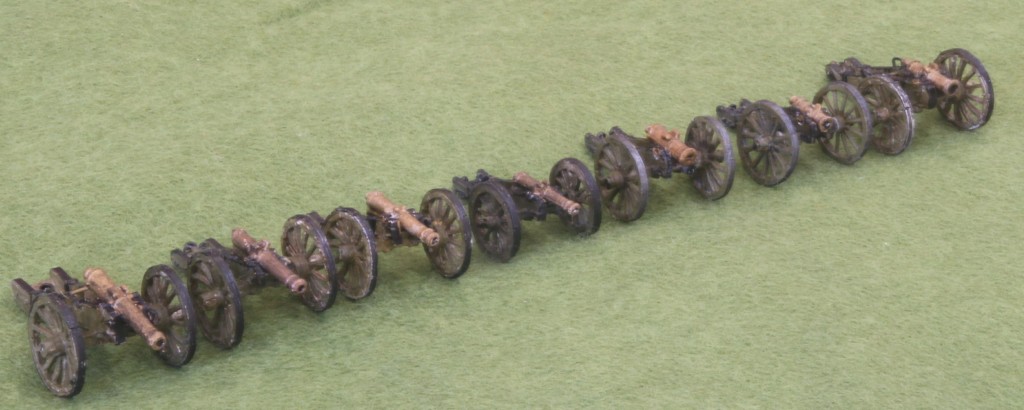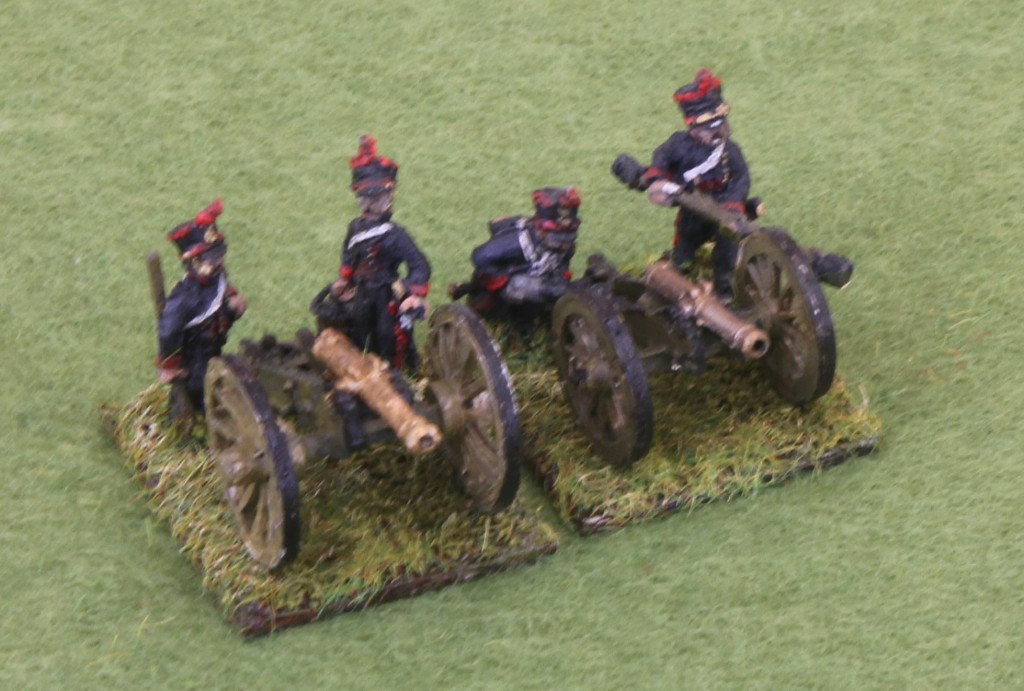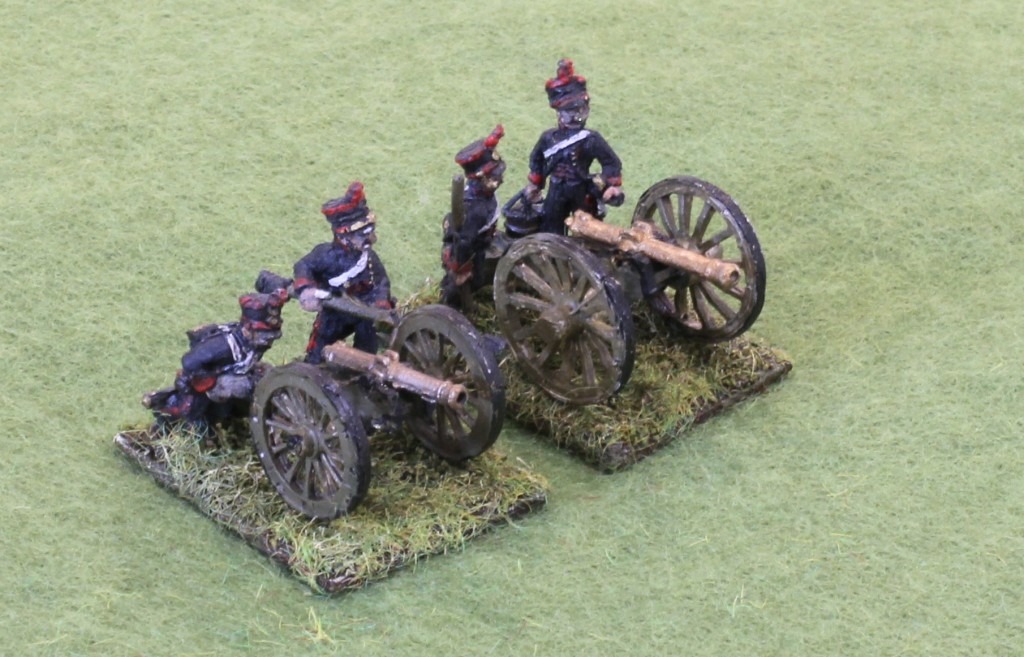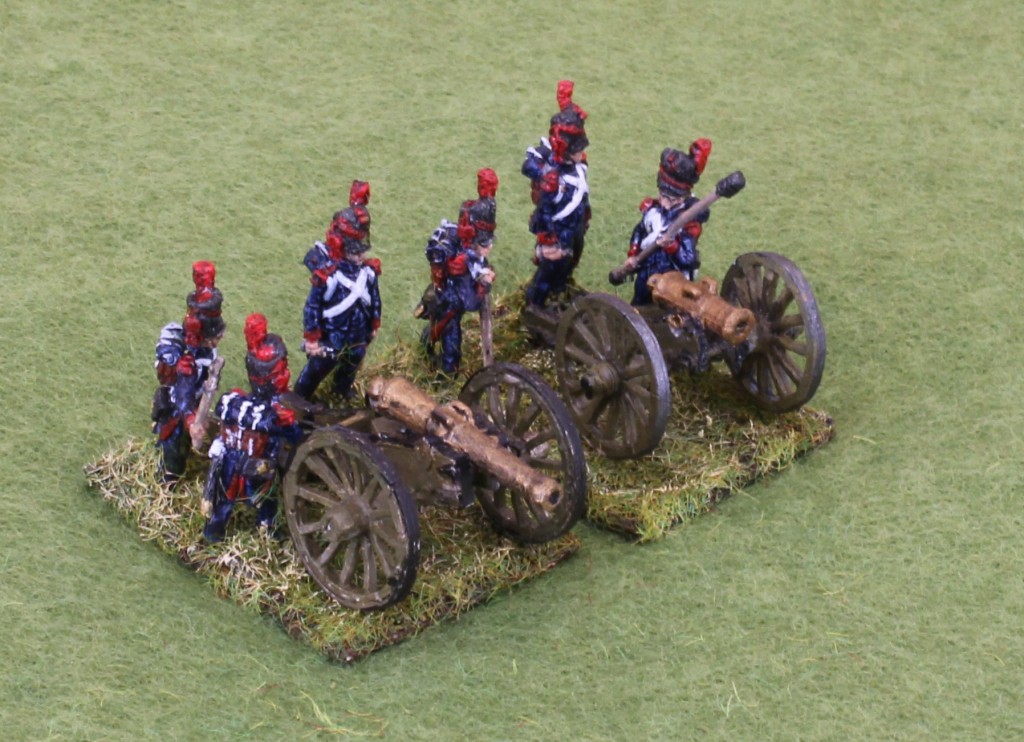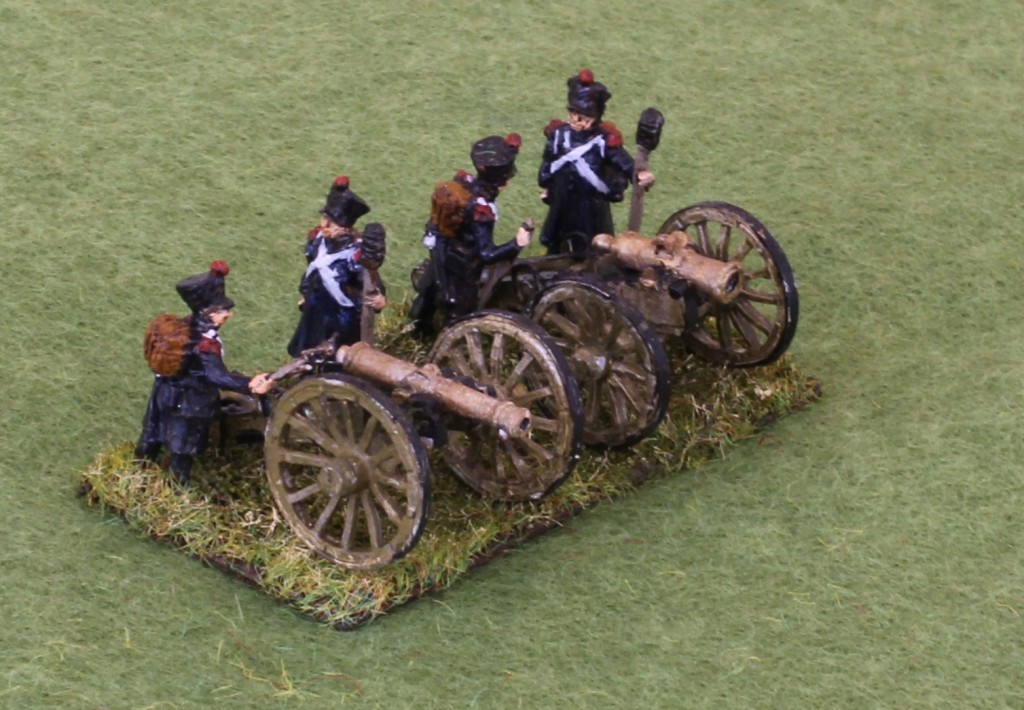A couple of weeks ago I considered the effect of skirmishing in wargames, with an especial focus on the grand tactical games that are my particular interest. This time I want to consider another topic that concerns such big-scope games: artillery fire at long range.
Looking at some standard works (Nafziger’s Imperial Bayonets; Dawson, Dawson, Summerfield’s Napoleonic artillery; the von Reisswitz Kriegsspiel) gives the following general picture. Effective artillery range is somewhere between 600m and 900m – with most commentators converging on the lower end of that range – no doubt this depends on conditions and weapon (a 12pdr might fire farther). Direct fire was theoretically possible up to 800m for a 6pdr, 1km for a 12pdr (Kriegsspiel figures). After this ricochet fire (or “random” fire or “Rollschuss”) could extend the range. Kriegsspiel suggests a maximum 1,350m for 6pdrs, or 1,500m for 12pdrs. Other evidence suggests that artillery could cause damage to targets for another 1Km. Howitzer ammunition couldn’t ricochet, but the Kriegsspiel statistics suggest similar maximum ranges (i.e 1.35Km for the 7pdr and 1.5Km for the 10pdr). The contemporary experts are quite clear, however, that firing at ranges beyond about 600m was a waste of ammunition.
But here we bump into one of the problems of simulation. What those sages pronounced in various manuals and treatises does not necessarily reflect the actual behaviour that we are trying to simulate. This is even starker, incidentally, with counter-battery fire, which the experts usually denounce as being a waste – but which was the almost universal practice of artillerymen (and, also, incidentally, quite successful at suppressing enemy artillery fire). The fact is that the effects of artillery fire could be significant at the grand tactical level at ranges of 1km and over.
Two case studies make this clear to me. The first is at Wagram in 1809. The effects of artillery fire during this battle were much commented on. Given the vast size of the field I think that a lot of this was conducted at ranges greater than 600m, but that is hard to pin down. In one particular case this does look clearer though. Massena’s corps disengaged from its position in the centre and marched across Austrian lines, but behind the French Grand Battery, to reinforce the Napoleon’s threatened left wing. In Gill’s account of this it suffered terribly from Austrian artillery fire: “beyond all description” according to one witness. And yet the Austrian guns cannot have been very close. Looking at the maps suggests 1Km or more. Much of this fire may have been directed at the grand battery in the first instance – though Gill’s description also suggests that Massena’s troops were also shielded by the corps’ own artillery leapfrogging forward as the troops advanced. All this suggests that the infantry was an indirect target in wargames terms, but that significant damage was done. No doubt the effect of Austrian fire was increased by an enfilade effect, as the fire was to the flank of the advancing columns, and the fact in moving the troops would not have been able to use the ground to avoid losses.
The second case study comes from Waterloo. Napoleon established a grand battery at the start of the battle on the ridge alongside La Belle Alliance inn. This was 1km away from the Allied troops on the opposite ridge. Some commentators (including Adkin in his wonderful tome on Waterloo) have suggested that the grand battery was deployed some 500m further forward on a slight rise in the intervening valley, about 200m short of La Haye Sainte. But the evidence from French participants is pretty clearly against this, though some batteries may have advanced to this position later in the battle. And the previous night there was quite a fierce exchange between the two ridges. The French conducted a bombardment at this range for an hour or so on the day. This does not seem to have done a huge amount of damage, attributed to the fact that the Allied infantry was sheltering behind the ridge, and that the ground had been softened by rain, preventing ricochet effects. And yet the fire was intense enough to be remarked upon by British witnesses – and British cavalry units, well behind the ridge, shifted position to a more sheltered spot to reduce casualties.
So we are talking about artillery fire having an effect at least to about 1.5Km, even behind undulations in the terrain. This seems to take two important forms. The first (like Waterloo) is a general cannonade, firing blind into an area where you expect enemy troops to be concentrated. The second is collateral fire – overshoots and bouncethroughs from direct targets that may have been closer at hand. The Spanish author of a series of “maxims” about artillery usage, quoted extensively by Nafziger, mentions that it is not a good idea to deploy artillery directly in front of infantry, as they are liable to be caught by fire aimed at the artillery. French officer and raconteur Elzéar Blaze also mentions this – how he hated being posted behind artillery. The point though about both these types of fire is that we are not considering the effects of aimed fire.
So what sort of damage could it do? Casualty rates are probably quite low, though an occasional direct hit on dense formations could be quite lethal. But Napoleon at Waterloo still thought it was worth doing. Damage could also be psychological. Direct hits could could cause disruption, perhaps. But I think the main effect is more subtle. Standing around under bombardment which you have to accept passively is often described as one of the most difficult tasks in war. It is likely to be psychologically draining in some way. But how this plays out is less easy to see. When the bombardment stops, as it must before any direct attack, the targets experience relief, which can take the form of fierce desire to get to grips with the enemy to relieve the pent-up frustration. I’m not sure how much evidence there really is of this kind of softening up causing the rapid collapse of trained troops. It happened in neither of the two instances I quoted above. At Wagram the Saxons did collapse on the second day from near Aderklaa after not much more than artillery fire. But that came after heavy losses on the first day, and then enduring fire “en potence” – from two directions. Much of this fire was likely was from less than 1Km, I suspect, though, at least for the units at the front.
My personal theory is that there is some sort of stamina limit, after which men feel that they have had enough – a come-down after a prolonged exposure to adrenaline. Towards the end of big battles there seem to be few troops available to do anything – far fewer than can be accounted for by dead and wounded. This was perhaps regarded as a bit shameful, so few people would write about it. But all knew it was a factor – and it comes through from Clausewitz’s writing. Exposure to bombardment perhaps sets the clock ticking, hastening that moment of eventual collapse, even if the men are perfectly capable as the bombardment ends. Wargames usually simulate this by having much higher rates of casualties than is justified by killed an wounded – and this is often very successful in simulating that end of battle scenario – though less good when it comes to simulating the effects of cannonades.
Fot tactical rules, matters are quite straightforward. Artillery fire at ranges of over 600m is probably not worth worrying about, though for games mechanics longer range brackets might be helpful. Though Lasalle isn’t very specific about its distance scale, this does seem to be the case with these rules. Older rules allow longer ranges, but these tended to tolerate useless detail more.
Turning to grand tactical rules Grande Armée and Volley & Bayonet have very similar mechanisms. Artillery units would target individual units (generally brigades), throw a small number of dice, and hope for high scores, which would give you hits. Ranges are quite long (1,000 to 1,600 yards) and little attempt is made to distinguish between long and effective range. In GA a hit immediately reduces combat effectiveness, in V&B the unit keeps going at the same capability until it is burnt out. The problem for both is similar to the one I was referred to in skirmishing – a low standard deviation attritional tactic comes out as a high standard deviation one. It has to be admitted though this may have a stronger basis in fact – as the results could indeed be quite variable, at least in terms of dead and wounded. There is no attempt to deal with bouncethroughs and indirect fire. In GA at least (I haven’t played V&B) players tend not to bother with preparatory bombardment for more than a token turn or so. The results seem to unreliable. Artillery can do a lot of damage, though its main impact is defensive.
Bloody Big Battles faces a similar issue, but it’s more extreme. A hit amounts to removing a base, which represents an extreme level of damage – that would not be realistic. Instead a lesser level of damage is inflicted: temporary disruption. But you have to act quite quickly to capitalise. Suppression of enemy artillery is probably a more useful goal for an attacker, though still requires a good score. Ranges are much longer than for other systems (2.4Km or more!), but they are designed mainly for a later era when artillery was punchier. Having said that I thought the ranges worked OK for my Waterloo simulation – in which I provided for bouncethrough and indirect fire in a house rule.
And now for my latest set of favourite rules: Et sans résultat! These are quite interesting in that they have a game mechanism referred to as “fatigue”, which operates at divisional level. This degrades the responsiveness of the division, and increases the risk of eventual panic or collapse. It has much less direct effect on combat. I think this models the psychological effects in a realistic way. And so these rules have two mechanisms with which to register the effects of bombardments. The first is direct damage to units , in the form of fairy conventional “hits”, which it handles at quite a low level of granularity (thus a 2,000 man brigade might have 20 or so strength points split between three “battalions” rather than a single brigade with about 4-5 points, as with GA or V&B, or just over a single base for BBB); and it has divisional fatigue with which to model the longer-term psychological impacts. The fatigue process also allows the effect of bombardments on the firing artillery – which was an important consideration for commanders at the time, but rarely bothered with by games designers. The core design, therefore, is very strong – though I can’t comment on what I would call “calibration” without more time on the games table.
But there’s a big snag with ESR. The weapons ranges are too short. Apart from point blank, there are two weapons ranges, up to 450 yards (400m) and up to 900 yards (800m). There’s another 200 yards or so of bouncethrough effect. This really only caters for the sort of short-range directly aimed fire that was mainly used on the defensive. The paradox is striking. At last a rules systems comes up with a good way of modelling the effects of long range cannonading – and then makes no allowance for players to actually do it. There is probably a deeper design problem here. The time frame of ESR moves is quite short (three an hour – it’s an hour for V&B or BBB!). If targets suffered one fatigue point a turn under long range bombardment, then this could be quite devastating. And yet if the effects were reduced in the typical way through randomisation (say a 50% chance of a fatigue loss) then this would give a high standard deviation over the typical 3 or 4 moves of a historical cannonade. It may well be that weapons ranges were brought down because cannonading proved to be too effective.
So how about my gestating grand tactical rules? I’m aiming for much higher granularity than ESR – boiling down to something quite similar to V&B (with bases of 1,500 men like BBB, but able to survive one or two hits). But I also want an equivalent of the fatigue system in ESR, to be operated by divisions. However, I was thinking of quite high granularity on that – say six levels (so that is can be marked by a six sided die). But with check points at hourly intervals, this might work. I plan to use hourly turns (though movement articulated in shorter time spans if required), with a cannonade phase at the start. Artillery must be committed at this stage, and markers placed on targets far and wide, including generous bouncethrough and indirect fire, up to at least 1.5Km. This is evaluated at the end of the turn – though I’m a bit vague on just how this will work. Finally the divisional fatigue/morale/cohesion will be assessed. The devil will be in the detail, as usual, though.
